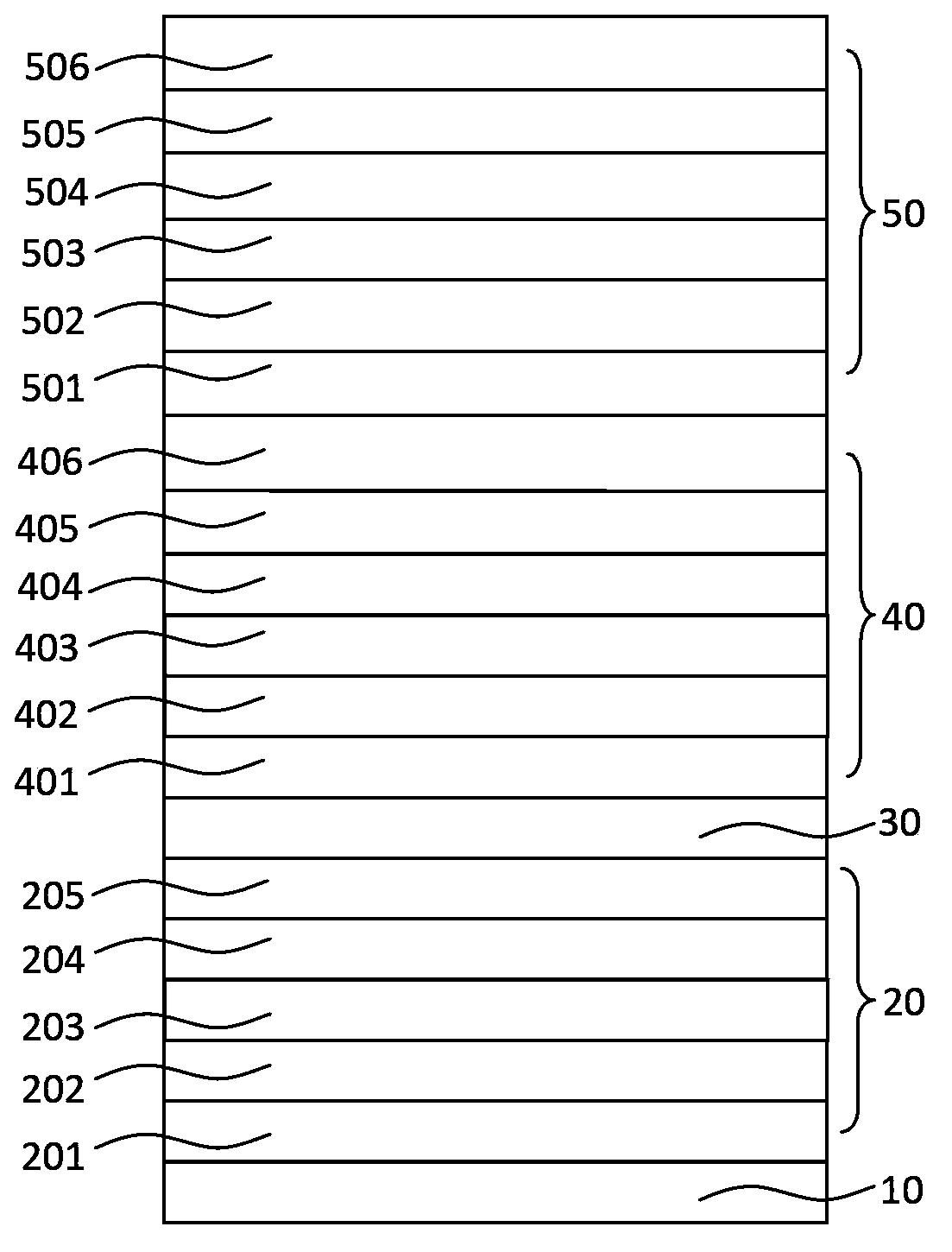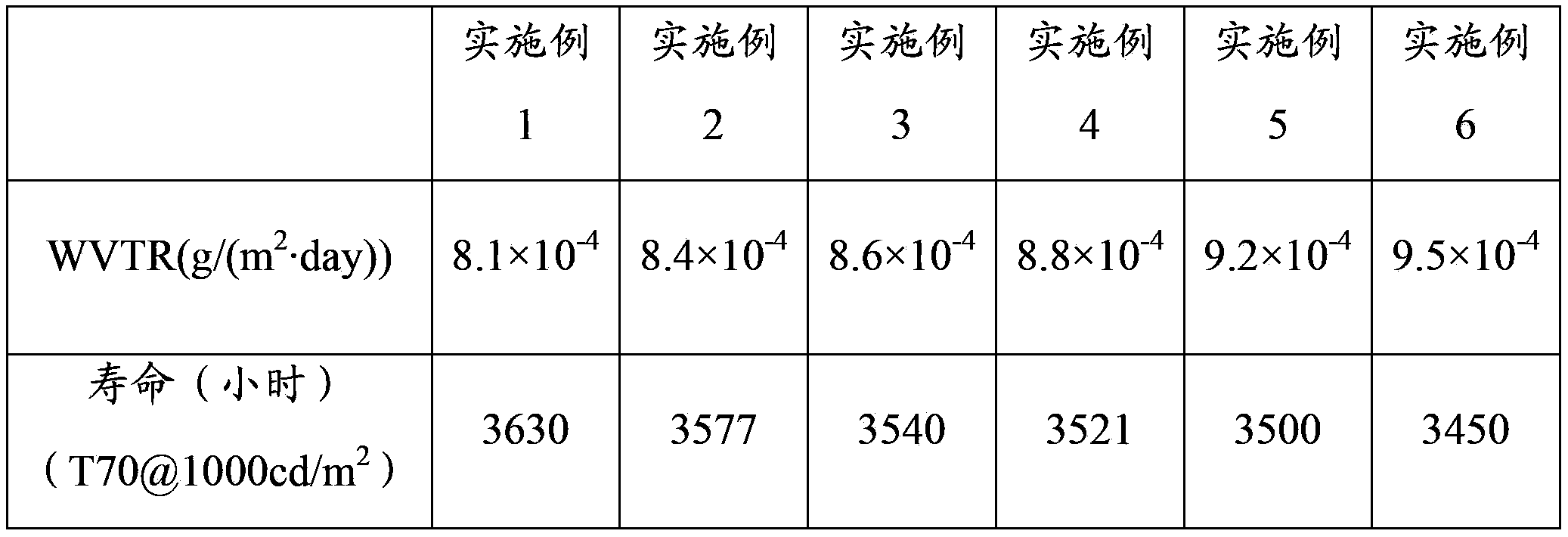Organic light-emitting diode and preparation method thereof
An electroluminescent device and luminescent technology, which are applied in the fields of electric solid-state devices, semiconductor/solid-state device manufacturing, electrical components, etc., can solve the problems of limiting the performance of flexible OLED products, weak waterproof and oxygen-proof ability, and complicated preparation process, etc., to achieve Good water vapor isolation effect, improved light transmittance, and high chemical stability
- Summary
- Abstract
- Description
- Claims
- Application Information
AI Technical Summary
Problems solved by technology
Method used
Image
Examples
Embodiment 1
[0117] An organic electroluminescent device is prepared through the following steps:
[0118] (1) Provide a clean anode conductive substrate:
[0119] Clean the ITO glass substrate with acetone, ethanol, deionized water, and ethanol in an ultrasonic cleaner in sequence, wash and wash for 5 minutes in one item, then blow dry with nitrogen, and dry in an oven for later use; surface activation of the cleaned ITO glass processing; ITO thickness is 100nm;
[0120] (2) Vacuum evaporation of the luminescent functional layer on the ITO glass substrate:
[0121] Specifically, the hole injection layer, the hole transport layer, the light emitting layer, the electron transport layer and the electron injection layer are prepared by vacuum evaporation in sequence;
[0122] Preparation of the hole injection layer: the MoO 3 Doped into NPB, the doping mass fraction is 30%, the thickness is 10nm, and the vacuum degree is 1×10 -5 Pa, evaporation rate
[0123] Preparation of the hole trans...
Embodiment 2
[0139] An organic electroluminescent device is prepared through the following steps:
[0140] (1), (2), (3) are the same as embodiment 1;
[0141] (4) Prepare the encapsulation layer on the outside of the cathode:
[0142] An encapsulation layer unit is prepared by the following method: sequentially vacuum evaporation to prepare the first organic barrier layer, the second organic barrier layer, the mixed barrier layer, the third organic barrier layer, the fourth organic barrier layer and the inorganic barrier layer, specifically :
[0143] Production of the first organic barrier layer: NPB is used as the material of the first organic barrier layer, and the vacuum degree is 1×10 -4 Pa, evaporation rate Thickness 300nm;
[0144] Production of the second organic barrier layer: BCP is used as the material of the second organic barrier layer, and the vacuum degree is 1×10 -4 Pa, evaporation rate Thickness 300nm;
[0145] Production of mixed barrier layer: The mixed barrier...
Embodiment 3
[0151] An organic electroluminescent device is prepared through the following steps:
[0152] (1), (2), (3) are the same as embodiment 1;
[0153] (4) Prepare the encapsulation layer on the outside of the cathode:
[0154] An encapsulation layer unit is prepared by the following method: sequentially vacuum evaporation to prepare the first organic barrier layer, the second organic barrier layer, the mixed barrier layer, the third organic barrier layer, the fourth organic barrier layer and the inorganic barrier layer, specifically :
[0155] Production of the first organic barrier layer: Alq3 is used as the material of the first organic barrier layer, and the vacuum degree is 1×10 -4 Pa, evaporation rate Thickness 250nm;
[0156] Production of the second organic barrier layer: TPBi is used as the material of the second organic barrier layer, and the vacuum degree is 1×10 -4 Pa, evaporation rate , thickness 250nm;
[0157] Production of mixed barrier layer: The mixed bar...
PUM
 Login to View More
Login to View More Abstract
Description
Claims
Application Information
 Login to View More
Login to View More - R&D
- Intellectual Property
- Life Sciences
- Materials
- Tech Scout
- Unparalleled Data Quality
- Higher Quality Content
- 60% Fewer Hallucinations
Browse by: Latest US Patents, China's latest patents, Technical Efficacy Thesaurus, Application Domain, Technology Topic, Popular Technical Reports.
© 2025 PatSnap. All rights reserved.Legal|Privacy policy|Modern Slavery Act Transparency Statement|Sitemap|About US| Contact US: help@patsnap.com


